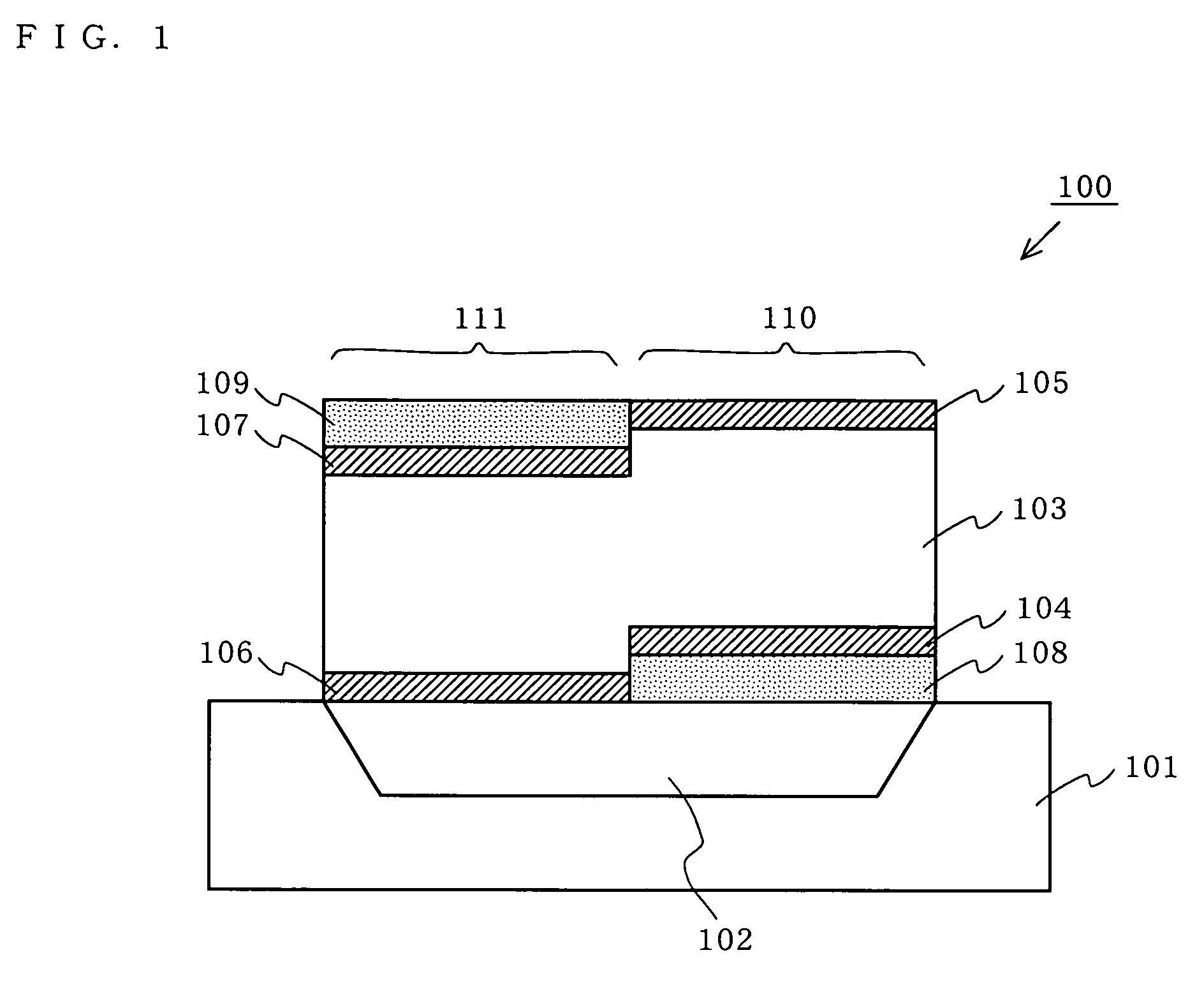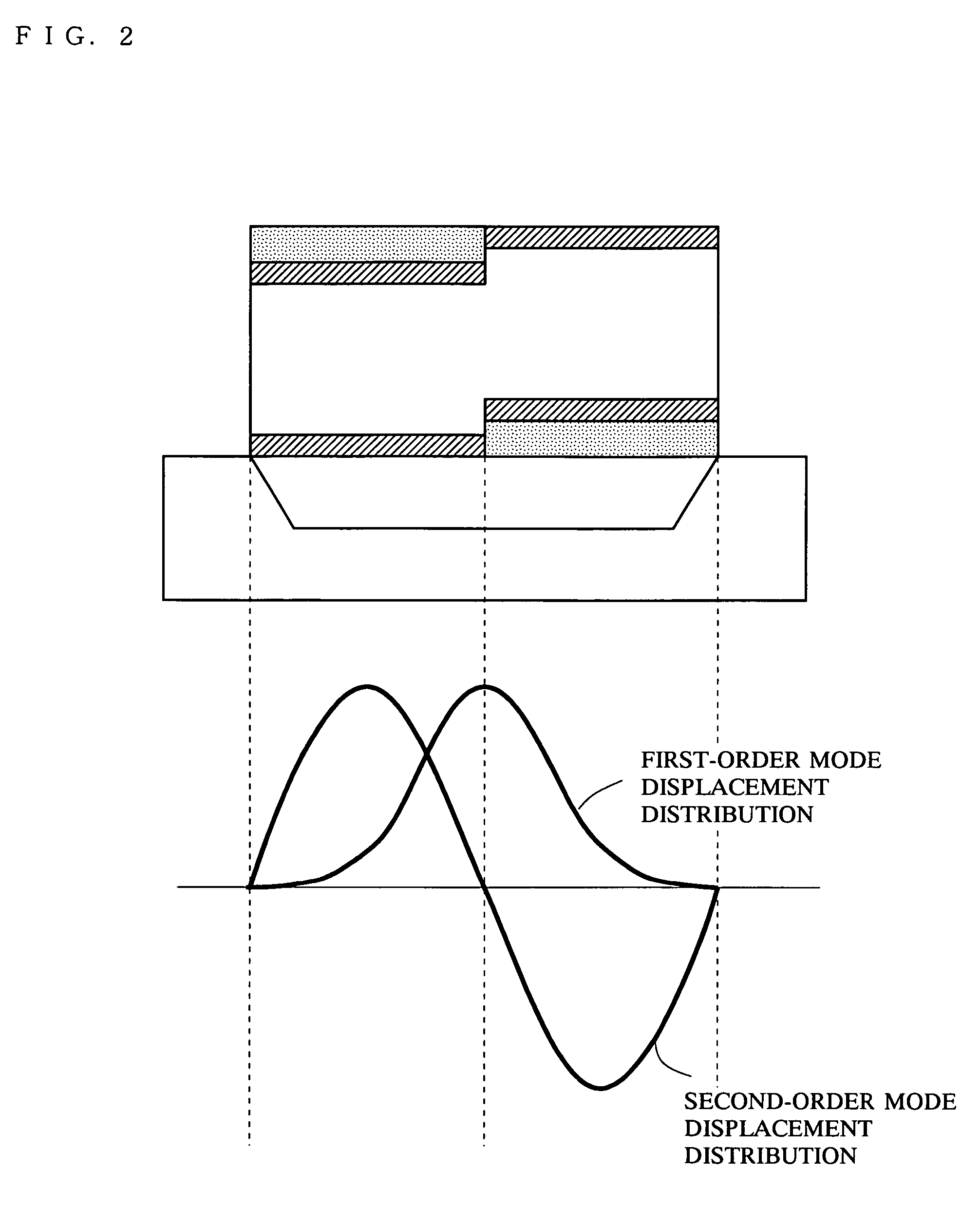Coupled FBAR filter
a filter and fbar technology, applied in the field of coupling fbar filters, can solve the problems of deteriorating filter characteristics and reducing filter characteristics to less, and achieve the effect of superb filter characteristics
- Summary
- Abstract
- Description
- Claims
- Application Information
AI Technical Summary
Benefits of technology
Problems solved by technology
Method used
Image
Examples
first embodiment
[0057]FIG. 1 is a cross-sectional view of a coupled FBAR filter 100 according to a first embodiment of the present invention. As shown in FIG. 1, the coupled FBAR filter 100 includes a substrate 101, a cavity 102, a piezoelectric thin film 103, a first lower electrode 104, a first upper electrode 105, a second lower electrode 106, a second upper electrode 107, a first insulator 108, and a second insulator 109.
[0058]The first and second lower electrodes 104 and 106, and the first and second upper electrodes 105 and 107, are formed of, for example, molybdenum (Mo). The piezoelectric thin film 103 is formed of a piezoelectric material such as, for example, aluminum nitride (AlN). The first and second insulators 108 and 109 are formed of, for example, silicon dioxide (SiO2).
[0059]First, a structure of the coupled FBAR filter 100 according to the first embodiment will be described in detail.
[0060]The first lower electrode 104, the first upper electrode 105, and a part of the piezoelectri...
second embodiment
[0073]In the first embodiment, the coupled FBAR filter suitable to a circuit (FIG. 3) in which the four electrodes 104 through 107 need to be insulated from one another is described. As shown in FIG. 5 and FIG. 8, a circuit in which two electrodes are grounded is often used for a coupled FBAR filter. In such a circuit, the two grounded electrodes do not need to be insulated. In other words, the feature 2 or the feature 3 does not need to be considered.
[0074]In a second embodiment, a coupled FBAR filter suitable to the circuit shown in FIG. 5 will be described.
[0075]FIG. 6 is a cross-sectional view of a coupled FBAR filter 300 according to the second embodiment of the present invention. As shown in FIG. 6, the coupled FBAR filter 300 includes a substrate 101, a cavity 102, a piezoelectric thin film 103, a lower electrode 304, a first upper electrode 105, a second upper electrode 107, and an insulator 109. As can be seen from FIG. 6, the second embodiment is different from the first e...
third embodiment
[0079]In a third embodiment, a coupled FBAR filter suitable to the circuit shown in FIG. 8 will be described.
[0080]FIG. 9 is a cross-sectional view of a coupled FBAR filter 500 according to the third embodiment of the present invention. As shown in FIG. 9, the coupled FBAR filter 500 includes a substrate 101, a cavity 102, a piezoelectric thin film 103, a first lower electrode 104, a second lower electrode 106, an upper electrode 505, and an insulator 108. As can be seen from FIG. 9, the third embodiment is different from the first embodiment in the structure of the upper electrode 505. Elements having an identical function to those of the first embodiment bear the same reference numerals thereto and the descriptions thereof will be omitted.
[0081]The first lower electrode 104, a part of the upper electrode 505, and a part of the piezoelectric thin film 103 interposed between these electrodes form a first input / output vibration portion 110. The second lower electrode 106, a part of t...
PUM
 Login to View More
Login to View More Abstract
Description
Claims
Application Information
 Login to View More
Login to View More - R&D
- Intellectual Property
- Life Sciences
- Materials
- Tech Scout
- Unparalleled Data Quality
- Higher Quality Content
- 60% Fewer Hallucinations
Browse by: Latest US Patents, China's latest patents, Technical Efficacy Thesaurus, Application Domain, Technology Topic, Popular Technical Reports.
© 2025 PatSnap. All rights reserved.Legal|Privacy policy|Modern Slavery Act Transparency Statement|Sitemap|About US| Contact US: help@patsnap.com



